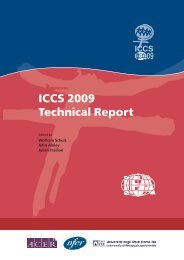Teacher Education and Development Study in Mathematics - IEA
Teacher Education and Development Study in Mathematics - IEA
Teacher Education and Development Study in Mathematics - IEA
You also want an ePaper? Increase the reach of your titles
YUMPU automatically turns print PDFs into web optimized ePapers that Google loves.
PART 2: UNITED STATES<br />
173<br />
<strong>Teacher</strong> pre-service education takes place <strong>in</strong> universities <strong>in</strong> schools of education. Middle<br />
<strong>and</strong> secondary school teachers generally major <strong>in</strong> the subject they teach, although this<br />
practice varies from state to state. The No Child Left Beh<strong>in</strong>d legislation (2001) requires<br />
schools <strong>in</strong> all states to hire only “qualified” teachers—teachers who meet certification<br />
requirements. However, because the states set the certification requirements, the<br />
def<strong>in</strong>ition of a “qualified” teacher varies from state to state.<br />
Nearly all teachers teach<strong>in</strong>g <strong>in</strong> a particular state are educated <strong>and</strong> certified <strong>in</strong> that state.<br />
More than 40 of the 50 states require teachers to take a state test to be certified. More<br />
recently, national certification programs have been developed that require already<br />
practic<strong>in</strong>g teachers to provide portfolios of their teach<strong>in</strong>g <strong>and</strong> to take a national test <strong>in</strong><br />
the subject that they <strong>in</strong>tend to teach. However, only a small percentage of teachers apply<br />
to be nationally certified. In most states, secondary school teachers must major <strong>in</strong> the<br />
subject they <strong>in</strong>tend to teach.<br />
<strong>Teacher</strong> salaries<br />
Movements <strong>in</strong> teacher salaries <strong>in</strong> the period 1970 to 2005 can be divided <strong>in</strong>to dist<strong>in</strong>ct<br />
periods. After a rapid rise of average teacher salaries <strong>in</strong> real terms <strong>in</strong> the 1960s (an<br />
<strong>in</strong>crease of approximately 33%), average salaries fell about 12% <strong>in</strong> constant dollars <strong>in</strong><br />
the 1970s, then rose more than 20% <strong>in</strong> the 1980s (NCES, 2004, Table 77). They have<br />
rema<strong>in</strong>ed more or less constant s<strong>in</strong>ce (see Figure 71 for the period 1980 to 2002).<br />
The salaries <strong>in</strong> Figure 71 are averages for the entire United States. However, salaries<br />
<strong>and</strong> changes <strong>in</strong> salaries for teachers vary greatly from state to state. A quick way to get<br />
some idea of this variation is to estimate <strong>in</strong>creases <strong>in</strong> spend<strong>in</strong>g per student between,<br />
say, 1980 <strong>and</strong> 2000. A list of various states (Table 49) shows how great this variation is<br />
(the average ratio of real spend<strong>in</strong>g per student between 1980 <strong>and</strong> 2000 was 1.58). The<br />
<strong>in</strong>crease <strong>in</strong> expenditure per student dur<strong>in</strong>g this 20-year period <strong>in</strong> states such as Arizona,<br />
California, Florida, <strong>and</strong> Louisiana was much less than the average for the United States<br />
as a whole. Spend<strong>in</strong>g per student <strong>in</strong> states such as Georgia, South Carol<strong>in</strong>a, Connecticut,<br />
<strong>and</strong> Texas over this period was considerably more than the average. Although the<br />
teacher salary <strong>in</strong>crease was much smaller than the overall <strong>in</strong>crease (20% versus 58%)<br />
because of lower teacher–student ratios <strong>and</strong> rapid <strong>in</strong>creases <strong>in</strong> the cost of ma<strong>in</strong>tenance,<br />
transportation, <strong>and</strong> (especially) special education, we can assume that those states with<br />
the greater <strong>in</strong>creases <strong>in</strong> overall spend<strong>in</strong>g per student were also those states where salaries<br />
<strong>in</strong>creased.<br />
From the st<strong>and</strong>po<strong>in</strong>t of recruitment, a ma<strong>in</strong> issue is how to keep <strong>in</strong>creas<strong>in</strong>g the number<br />
of teachers <strong>in</strong> the United States if real teacher salaries are not <strong>in</strong>creas<strong>in</strong>g (see Figure<br />
70 above). It is important to keep <strong>in</strong> m<strong>in</strong>d, however, that while it may be possible to<br />
recruit more teachers, the quality of the teachers <strong>in</strong> terms of their capacity to teach, say,<br />
mathematics, will doubtless depend on salaries <strong>in</strong> compet<strong>in</strong>g professions. We exam<strong>in</strong>e<br />
this issue below.<br />
One of the most important factors affect<strong>in</strong>g both teacher salary <strong>in</strong>creases <strong>and</strong><br />
recruitment is the rise <strong>in</strong> the real wages of university-educated females (<strong>and</strong> females <strong>in</strong><br />
general) <strong>in</strong> absolute terms <strong>and</strong> relative to male wages, over the past 30 years. The s<strong>in</strong>gle<br />
most important explanation for the rapid <strong>in</strong>crease <strong>in</strong> teacher salaries <strong>in</strong> the 1980s, for<br />
example, is the correspond<strong>in</strong>g rise <strong>in</strong> female’s real wages <strong>in</strong> that decade. Accord<strong>in</strong>g to<br />
estimates by the Economic Policy Institute (Wash<strong>in</strong>gton, DC), the real wages of female<br />
college graduates <strong>in</strong>creased 17% <strong>in</strong> the 1980s (compared to only a two percent <strong>in</strong>crease

















